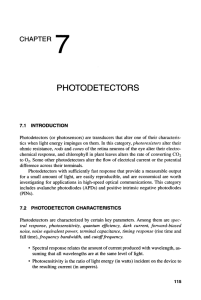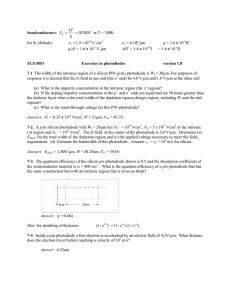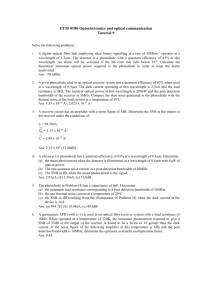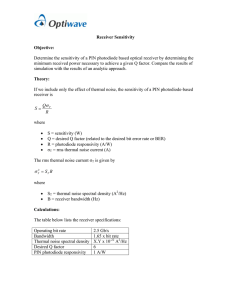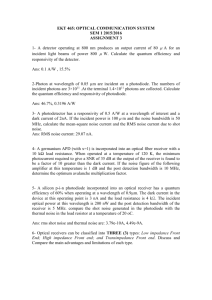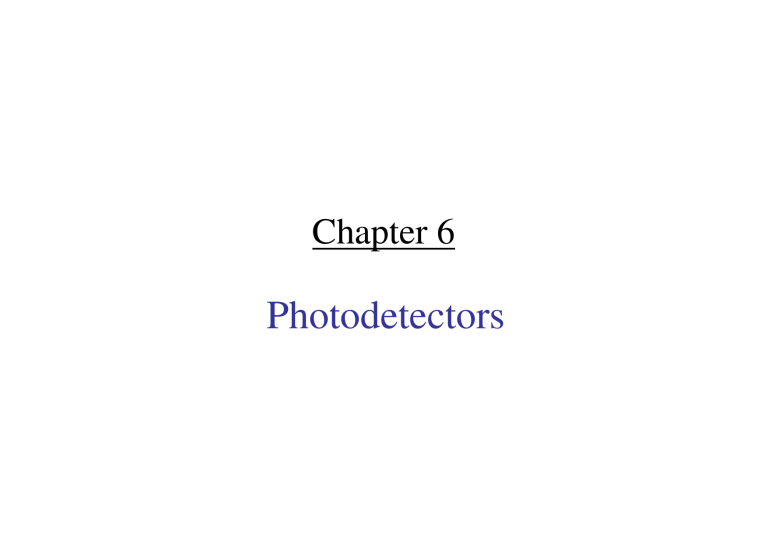
Chapter 6 Photodetectors Content • Physical Principles of Photodiodes • pin, APD • Photodetectors characteristics (Quantum efficiency, Responsivity, S/N) • Noise in Photodetector Circuits • Photodiode Response Time • Photodiodes structures Photodetectors These are Opto-electric devices i.e. to convert the optical signal back into electrical impulses. The light detectors are commonly made up of semiconductor material. When the light strikes the light detector a current is produced in the external circuit proportional to the intensity of the incident light. Photodetectors Optical signal generally is weakened and distorted when it emerges from the end of the fiber, the photodetector must meet following strict performance requirements. A high sensitivity to the emission wavelength range of the received light signal A minimum addition of noise to the signal A fast response speed to handle the desired data rate Be insensitive to temperature variations Be compatible with the physical dimensions of the fiber Have a Reasonable cost compared to other system components Have a long operating lifetime Photodetectors Some important parameters while discussing photodetectors: Quantum Efficiency It is the ratio of primary electron-hole pairs created by incident photon to the photon incident on the diode material. Detector Responsivity This is the ratio of output current to input optical power. Hence this is the efficiency of the device. Spectral Response Range This is the range of wavelengths over which the device will operate. Noise Characteristics The level of noise produced in the device is critical to its operation at low levels of input light. Response Time This is a measure of how quickly the detector can respond to variations in the input light intensity. Photodetectors Types of Light Detectors PIN Photodiode Avalanche Photodiode PIN photodiode InGaAs avalanche photodiode Photodetectors Photodetector materials Operating Wavelength Ranges for Several Different Photodetector Materials InGaAs is used most commonly for both long-wavelength pin and avalanche photodiodes Physical Principles of Photodiodes The Pin Photodetector The device structure consists of p and n semiconductor regions separated by a very lightly n-doped intrinsic (i) region. In normal operation a reverse-bias voltage is applied across the device so that no free electrons or holes exist in the intrinsic region. Incident photon having energy greater than or equal to the bandgap energy of the semiconductor material, give up its energy and excite an electron from the valence band to the conduction band pin Photodetector w The high electric field present in the depletion region causes photogenerated carriers to separate and be collected across the reverse – biased junction. This gives rise to a current flow in an external circuit, known as photocurrent. The Pin Photodetector Photocarriers: Incident photon, generates free (mobile) electron-hole pairs in the intrinsic region. These charge carriers are known as photocarriers, since they are generated by a photon. Photocurrent: The electric field across the device causes the photocarriers to be swept out of the intrinsic region, thereby giving rise to a current flow in an external circuit. This current flow is known as the photocurrent. Energy-Band diagram for a pin photodiode The Pin Photodetector An incident photon is able to boost an electron to the conduction band only if it has an energy that is greater than or equal to the bandgap energy **Beyond a certain wavelength, the light will not be absorbed by the material since the wavelength of a photon is inversely proportional to its energy Thus, a particular semiconductor material can be used only over a limited wavelength range. The upper wavelength λc cutoff is determined by the band-gap energy Eg of the material. • As the charge carriers flow through the material some of them recombine and disappear. • The charge carriers move a distance Ln or Lp for electrons and holes before recombining. This distance is known as diffusion length • The time it take to recombine is its life time τn or τp respectively. Ln = (Dn τn)1/2 and Lp = (Dp τp)1/2 • Where Dn and Dp are the diffusion coefficients for electrons and holes respectively. Photocurrent • As a photon flux penetrates through the semiconductor, it will be absorbed. • If Pin is the optical power falling on the photo detector at x=0 and P(x) is the power level at a distance x into the material then the incremental change be given as dP( x ) = −α s (λ )P( x )dx where αs(λ) is the photon absorption coefficient at a wavelength λ. So that P( x ) = Pin exp(− α s x ) Photocurrent • Optical power absorbed, P(x), in the depletion region can be written in terms of incident optical power, Pin : P( x) = Pin (1 − e −α s ( λ ) x ) [6-1] • Absorption coefficient αs (λ) strongly depends on wavelength. The upper wavelength cutoff for any semiconductor can be determined by its energy gap as follows: 1 . 24 [6-2] λc (µm ) = E g (eV) • Taking entrance face reflectivity into consideration, the absorbed power in the width of depletion region, w, becomes: (1− Rf )P(w) = Pin (1− e−αs (λ)w )(1− Rf ) Optical Absorption Coefficient Responsivity • The primary photocurrent resulting from absorption is: q I p = Pin (1− e−αs (λ)w )(1− Rf ) hν [6-3] • Quantum Efficiency: # of electron - hole photogener ated pairs # of incident photons I /q η= P Pin / h ν η= [6-4] • Responsivity: ηq IP ℜ = = Pin hν [A/W] [6-5] Responsivity vs. wavelength Typical Silicon P-I-N Diode Schematic The Pin Photodetector Generic Operating Parameters of an InGaAs pin Photodiode Avalanche Photodiode (APD) APDs internally multiply the primary photocurrent before it enters to following circuitry. In order to carrier multiplication take place, the photogenerated carriers must traverse along a high field region. In this region, photogenerated electrons and holes gain enough energy to ionize bound electrons in VB upon colliding with them. This multiplication is known as impact ionization. The newly created carriers in the presence of high electric field result in more ionization called avalanche effect. Optical radiation Reach-Through APD structure (RAPD) showing the electric fields in depletion region and multiplication region. Avalanche Photodiodes Ionization rate The average number of electron-hole pairs created by a carrier per unit distance traveled is called the ionization rate. Most materials exhibit different electron ionization rates α and hole ionization rates β. The ratio k = β / α of the two ionization rates is a measure of the photodetector performance. Only silicon has a significant difference between electron and hole ionization rates. Responsivity of APD • The multiplication factor (current gain) M for all carriers generated in the photodiode is defined as: IM M = Ip [6-6] where IM is the average value of the total multiplied output current & Ip is the primary photocurrent. • The responsivity of APD can be calculated by considering the current gain as: ℜ APD ηq = M = ℜ 0M hν [6-7] Current gain (M) vs. Voltage for different optical wavelengths Generic Operating Parameters of an InGaAs Avalanche Photodiode Photodetector Noise & S/N • Detection of weak optical signal requires that the photodetector and its following amplification circuitry be optimized for a desired signal-to-noise ratio. • It is the noise current which determines the minimum optical power level that can be detected. This minimum detectable optical power defines the sensitivity of photodetector. That is the optical power that generates a photocurrent with the amplitude equal to that of the total noise current (S/N=1) S signal power from photocurre nt = N photodetec tor noise power + amplifier noise power Signal Calculation • Consider the modulated optical power signal P(t) falls on the photodetector with the form of: P (t ) = P0 [1 + ms (t )] [6-8] • Where s(t) is message electrical signal and m is modulation index. Therefore the primary photocurrent is (for pin photodiode M=1): ηq i ph = MP ( t ) = I P [ DC value ] + i p ( t )[ AC current ] hν • The mean square signal current is then: Signal Power Signal Component is 2 ip 2 = ip M 2 = σ s 2 =σp 2 m 2 I P2 = 2 [6-9] [6-9] 2 For sinusoidally varying signal s(t) of modulation index m [6-10] Noise Sources in Photodetecors • The principal noises associated with photodetectors are : 1- Quantum (Shot) noise: arises from statistical nature of the production and collection of photo-generated electrons upon optical illumination. It has been shown that the statistics follow a Poisson process. 2- Dark current noise: is the current that continues to flow through the bias circuit in the absence of the light. This is the combination of bulk dark current, which is due to thermally generated e and h in the pn junction, and the surface dark current, due to surface defects, bias voltage and surface area. • Surface dark current is also known as surface leakage current. It depends on surface defects, cleanliness, bias voltage and surface area. The surface currnt can be reduced by using the guard rings so that the surface current should not flow through the load resistor • In order to calculate the total noise present in photodetector, we should sum up the root mean square of each noise current by assuming that those are uncorrelated. Total photodetector noise current=quantum noise current +bulk dark current noise + surface current noise Noise calculation (1) • Quantum noise current (lower limit on the sensitivity): 2 shot i =σ 2 shot = 2qIP BM 2 F (M ) [6-13] B: Bandwidth, F(M) is the noise figure and generally is Note that for pin photodiode F ( M ) ≈ M x 0 ≤ x ≤ 1 .0 2 M F (M ) = 1 • Bulk dark current noise: i DB 2 2 = σ DB = 2qI D BM 2 F ( M ) [6-14] ID is primary (unmultiplied) bulk dark current. • Surface dark current noise: IL is the surface leakage current. i DS 2 2 = σ DS = 2 qI L B [6-15] Noise calculation (2) • Since the dark current and the signal current are totally uncorrelated so the total ms photodetector noise current is: iN 2 = σ N = iQ 2 2 + iDB 2 + iDS 2 = 2q( I P + I D ) BM 2 F ( M ) + 2qI L B [6-16] • The thermal noise of amplifier connected to the photodetector is: [Assumption: amplifier input impedance is much greater than the load resistor] iT 2 4kBTB 2 = σT = RL [6-17] k B = 1 . 38 × 10 − 23 JK -1 RL is the input resistance of amplifier, and kB is Boltzmann’s constant. S/N Calculation • Having obtained the signal and total noise, the signal-to-noiseratio can be written as: 2 2 iP M S [6-18] = N 2q( I P + I D ) BM 2 F (M ) + 2qI L B + 4k BTB / RL • Since the noise figure F(M) increases with M, there always exists an optimum value of M that maximizes the S/N. For sinusoidally modulated signal with m=1 and : F (M ) ≈ M x M x+2 opt 2 qI L + 4 k B T / R L = xq ( I P + I D ) [6-19] Detector Response Time The response time of photodiode together with its output circuit depends mainly on the following three factors: 1.The transit time of the photocarriers in the depletion region. 2.The diffusion time of the photocarriers generated outside the depletion region. 3.The RC time constant of the photodiode and its associated circuit. Reverse-biased pin photodiode Schematic representation of a reversed biased pin photodiode Depletion Layer Photocurrent • Under steady state the total current flowing through the depletion layer is Jtotal = Jdr + Jdiff • Jdr is the drift current from the carriers inside the depletion region • Jdiff is the current due to the carriers generated outside the depletion region (in n or p side) and diffuses into the reverse bias region. The drift current Ip density is −α w J dr = where Φo = ( ) = qΦ o 1 − e A Pin (1 − R f Ahν s ) Depletion Layer Photocurrent • The surface p layer of a pin photodiode is normally very thin. The diffusion current is mainly due to the holes diffusion from bulk n region. The hole diffusion in the material can be determined by the one dimensional diffusion equation ∂ 2 pn pn − pn 0 Dp − + G (x ) = 0 2 ∂x τp • Where Dp is the hole diffusion constant, pn is the hole concentration in the n-type material, τp is the excess hole life time, pno is the equilibrium hole density, and G(x) is the electron-hole generation rate. Depletion Layer Photocurrent Diffusion current: • Solving the diffusion equation using the electron hole generation rate G ( x) = Φ 0α s e −α s x • The diffusion current density is given as α s L p −α x Dp J diff = qΦ 0 e + qpn 0 1 + α s Lp Lp s • The total current density can be written as J tot Dp e −α s x = qΦ 0 1 − + qpn 0 Lp 1 + α s L p Photodetector Response Time • The response time of a photo detector with its output circuit depends mainly on the following three factors: 1- The transit time of the photo carriers in the depletion region. The transit time t d depends on the carrier drift velocity v d and the depletion layer width w, and is given by: td w = vd [6-27] 2- Diffusion time of photocarriers outside depletion region. 3- RC time constant of the circuit. The circuit after the photodetector acts like RC low pass filter with a passband given 1 by: B= [6-29] 2πRT C T RT = Rs || RL and CT = Ca + Cd Detector Response Time The photodiode parameters responsible for these three factors (transient time, diffusion time, RC time constant) are: 1. Absorption coefficient α 2. Depletion region width 3. Photodiode junction and package capacitance 4. Amplifier capacitance 5. Detector load resistor 6. Amplifier input resistance 7. Photodiode series resistance Detector Response Time The diffusion processes are slow compared with the drift of carriers in the high field region. To have a high speed photodiode: •Photocarriers should be generated in the depletion region or close to the depletion region. •Diffusion times should be less than or equal to the carrier drift times. The effect of long diffusion times can be seen by considering the photodiode response time. Detector Response Time Response time is described by the rise time and the fall time of the detector output when the detector is illuminated by the step input of optical radiation. The rise time is typically measured from the 10 to 90 percent points of the leading edge of the output pulse. For Fully depleted photodiodes the rise time and the fall time are generally the same. They can be different at low bias levels where the photodiode is not fully depleted. Fast carriers Charge carriers produced in the depletion region are separated and collected quickly. Slow carriers Electron hole pairs generated in the n and p regions must slowly diffuse to the depletion region before they can be separated and collected. Photodiode response to optical pulse Typical response time of the photodiode that is not fully depleted Various optical responses of photodetectors: Trade-off between quantum efficiency & response time • To achieve a high quantum efficiency, the depletion layer width must be larger than 1 / α s (the inverse of the absorption coefficient), so that most of the light will be absorbed. At the same time with large width, the capacitance is small and RC time constant getting smaller, leading to faster response, but wide width results in larger transit time in the depletion region. Therefore there is a trade-off between width and QE. It is shown that the best is: 1/αs ≤ w≤ 2/αs Structures for InGaAs APDs • Separate-absorption-and multiplication (SAM) APD light substrate buffer layer INGaAs Absorption layer multiplication layer Metal contact • InGaAs APD superlattice structure (The multiplication region is composed of several layers of InAlGaAs quantum wells separated by InAlAs barrier layers. Temperature effect on avalanche gain Comparison of photodetectors
